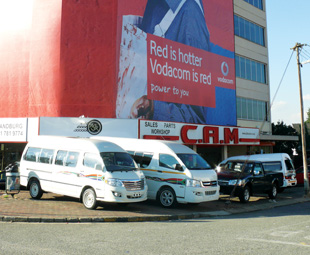No end in sight for South Africa’s ”death traps”

General Motors, through its subsidiaries in East and South Africa, is now deeply involved in sub-Saharan countries to replace minibus taxis with 32-seater buses. But in South Africa there are no plans – yet – to ban the death traps from our roads despite the fatalities, injuries and road rage they cause, writes UDO RYPSTRA.
Kenya is already doing it and now Zimbabwe plans to do the same: banning minibus taxis with less than 26-seats to reduce traffic congestion and the slaughter on their roads caused by rickety 14 and 15-seaters that should have seen a scrapyard years ago.
Other sub-Saharan countries, Uganda, Angola and Mozambique are also going for bigger vehicles, with Kampala having ordered 522 30-seaters from China recently. No fewer than 1 000 Chinese buses were landed in Luanda recently, while Maputo is also in the process of upgrading its bus fleet.
And they are also doing it, along with South Africa, in response to international protocols on transport and communications that they have signed. Countries like Kenya and Tanzania have already moved towards 32-seater and bigger buses, saying it has resulted in reduced traffic congestion, as there are fewer buses on the streets. The use of larger buses has also resulted in a reduction of road accidents and fatalities.
Earlier this year, the Kenyan government issued a directive that no new 14-seater matatus will be registered, while those in operation will not be allowed in central business districts.
Nairobi alone has about 13 000 matatus, mostly refurbished imported vehicles, and the policy shift will cost Sh220 million. The government has also indicated that from next year, matatu owners will have to operate either in saccos or registered companies. Already 70 of these have registered.
General Motors East Africa, with input from General Motors South Africa, is now setting up the infrastructure to supply the 32-seaters. An article appearing in Kenya’s Daily Nation newspaper stated that Nairobi will require 7 000 of these vehicles to replace the 14-seater vans, according to a government policy aimed at decongesting the city.
Speaking during a press conference at GM East Africa recently, managing director Bill Lay said the motor vehicle assemblers have the capacity to manufacture the vehicles with funding from financial institutions. GM, Kenya Vehicle Manufacturers and Assemblers Association were operating at 30 per cent capacity, and had ability to increase production in a short period, he said.
According to Lay, 70 per cent of the public transport in the country comprised 14-seater matatus. GM, the distributor of Isuzu vehicles, was already hiring engineers and mechanics and it was estimated that an additional 100 people would be employed, while the firm’s suppliers and body builders would employ another 500 as the transition took off. “This is expected to be replicated at other assembly plants, further compounding the benefits to the economy,” Lay was quoted as saying.
The Zimbabwean government is now also working on a draft National Transport Policy that seeks the phasing out of commuter buses that carry less than 26 passengers. Among the various proposals in the draft policy document are promotion of high-capacity transport modes such as trains and articulated buses and the gradual phasing out of small minibuses.
Speaking during a tour of Harare-based company, Sub-Sahara Africa Buses (SSAB) recently, secretary for Transport, Communication and Infrastructural Development, Partson Mbiriri told reporters his ministry endorsed the thrust and looked forward to progress on the Zimbabwean market.
GM, whose Isuzu truck chassis are also converted into buses in SA, is already involved in a project to supply Zimbabwe with more than 500 32-seaters this year. SSAB claims it will soon have the capacity to annually assemble at least 500 32-seater buses in collaboration with General Motors East Africa, as well as GMSA, which will help with the production. The deal was engineered by Autoworld, Zimbabwe’s Isuzu distributor, which will supply key components, back-up kits and guarantee the after sales warranty.
The project forecasts to create 3 000 direct jobs and a further 20 000 in downstream industries. The draft policy seeks to align Zimbabwe with various international protocols on transport and communication, including the SADC Protocol on Transport, Communication and Meteorology, the Comesa Transport Policy Framework and Strategies, and the AU Protocol on Transport, Communications and Tourism.
The case for South Africa following the same route is getting stronger by the day as South Africa’s taxi industry continues to hit the news for all the wrong reasons – for causing traffic congestion, for its bad safety record, for its ongoing taxi wars over transport routes, for downing tools when its got a gripe against something and inconveniencing the masses.
The traffic congestion that small taxis cause is an ongoing major cause of concern.
According to the DoT, South Africa’s taxi fleet was estimated to have been 120 000 vehicles in 2000. This has since risen to an estimated 150 000 taxis today, which is totally against one of the objectives of the taxi recapitalisation programme.
In 2005, the taxi recapitalisation programme was started, along with compulsory registration of taxis in the hope of reducing this number to 80 000. While the recap programme has met with some degree of success (to take old taxis off the road and legalising taxis), there are now an estimated 150 000 taxis on SA roads. Many drivers are unlicensed and the havoc and anger they cause through negligent, if not reckless driving and ignoring traffic rules, causes road accidents and public outrage.
According to a study done by the Automobile Association (AA), there are now an average of 70 000 accidents a year involving taxis, double the rate of crashes for all other passenger vehicles.
Overloading, a major cause of taxi accidents, is rife. A report by the SA Vehicle and Bodybuilders’ Association, submitted to the Western Cape transport department technical committee earlier this year, states taxis are being overloaded from the moment they leave the factory. After a series of tests using a Toyota Quantum 14-seater Tourer and a Toyota Quantum Ses’fikile – both popular taxis in the country – the association found that in both instances the vehicles exceeded their gross vehicle mass and tyre load limits once loaded with “average South African commuters”.
The report has asked for a redefinition of the weight of the average South African saying the current “68 kg including luggage is outdated and one has to bear in mind that the international standard is 75 kg”. Besides this, taxis are being deliberately overloaded – in recent months taxis have been pulled over with more than 40 children on board!
Despite the registration process to be followed, taxi wars over taxi routes continue. Last month, unknown gunmen shot a 50-year-old taxi owner in the chest outside his house in Roerfontein village in Sekgosese outside Polokwane. The motive for the shooting is unknown, but suspected to be the result of a taxi related dispute. In another separate incident in Limpopo, commuters were forced to use other means of transport to reach work following taxi violence between the Apel and Sekhukhune taxi associations, during which two taxis were hijacked, one set alight, while another was damaged due to stone throwing.
Add to this taxi strikes – one in Cape Town last month over “unfair” police treatment – and it remains a maverick industry that does what it pleases. Further strikes are possible if the new tolling fees for Gauteng’s new freeway system are deemed too high, as the industry has already tried in vain to get exemption from those fees, but will be given the same discounts as registered bus operators.
South Africa will have to live with the minibus taxi industry for another decade at least because banning the death traps from our roads could trigger another public outcry. As Deputy-Minister of Transport Jeremy Cronin put it in reply to a question relating to the average weight of South Africans: “Over 60% of public transport users are reliant on minibuses … If one took all the non-compliant taxis off the road tomorrow, there would be a popular revolt, not just from the side of the taxis, but from ordinary people who are dependent on them for mobility,” he said.
The good news is that there is a new strategy in place to improve the taxi industry and that the number and quality of registered minibuses, which have to comply with TRP safety specifications, is increasing. This applies especially to Toyota Ses’fikile Quantum, of which there is now also a diesel-powered version, the dedicated Sprinter taxi from Mercedes Benz, dubbed the ‘Inkanyezi’ – which means ‘the star’ in Zulu, and will probably also apply to Volkswagen’s Crafter, to be introduced later in the year.
Manufacturers would not introduce these new vehicles unless they were sure there was a future for their use.
Published by
Focus on Transport
focusmagsa




